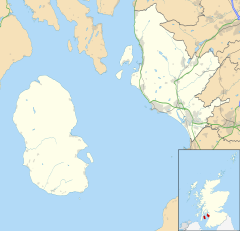Drakemyre, North Ayrshire
| Drakemyre | |
|---|---|
| Drakemyre shown within North Ayrshire | |
| OS grid reference | NS29115 50338 |
| Council area | |
| Lieutenancy area | |
| Country | Scotland |
| Sovereign state | United Kingdom |
| Post town | Dalry |
| Dialling code | 01294 |
| Police | Scottish |
| Fire | Scottish |
| Ambulance | Scottish |
| EU Parliament | Scotland |
| UK Parliament | |
| Scottish Parliament | |
Drakemyre or Drakemire was once a distinct village on the Rye Water in North Ayrshire, Parish of Dalry, Scotland. The settlement on the B780 road to Kilbirnie has become incorporated as a suburb within the town of Dalry.
In the 1870s it was recorded as forming a northern suburb of Dalry with woollen manufactories such as Doggartland Mill and a population of 325.
The cottages of Fordmouth record that a ford on the Rye Water existed until a bridge was built nearby at Bridge End.
The 'Trades Hotel' was a lodging house where itinerant workers could stay for sixpence a night.
"By Drakemyre we descend - see the claith-spread enclosure
Emblazoned by evry bright colour and dye;
Saint Margaret hersel' ne'er displayed
sic braw dresses As are worn ilka day by the wives of Dalry".
Andrew Aitken 1873
The old village of Burnside lies slightly further north and once had the school that served the area.
Doggartland House at Drakemyre may derive its name from 'Dogger' which is Scots for a course ironstone, much mined in the area as witnessed by waste bings below Ryefield and at Flashwood. An impressive, but now largely redundant cast iron bridge crosses the Rye Water within the grounds of Doggartland House. This bridge has very elaborate cast-iron balustrades and the nearby house has been described as 'Italianate' and the driveway is guarded by two pairs of quirky gatepiers, one tall and the other small, octagonal with panels at the top (See photograph).
Doggartland Farm was the property of the Blair Estate in the 1870s. The name element 'Doggart' is recorded as 'Douat' by Timothy Pont in the early 17th century.
Ryefield House was described as "almost new" in 1851 and the estate possessed a fine 'U-shaped' stable block with a courtyard to the east of the mansion house as well as a large walled garden to the west. The mansion house is of a classical style, built of ashlar with a Doric porch and in the 1920s a single storey ballroom was added, also used as an art gallery by William Barr Knox. William first married Gladys Burrell, a niece of Sir William Burrell the Scottish shipping merchant and philanthropist, made famous through the Burrell Collection. Edith Dunlop of Strathaven was the second wife of William Barr Knox, he is buried in Largs, however a commemorative plaque is also present at the Knox family memorial in Kilbirne 'Auld Kirk' cemetery where he is recorded as being of 'Redheugh and Ryefield'. His daughter was named Diana.
...
Wikipedia

